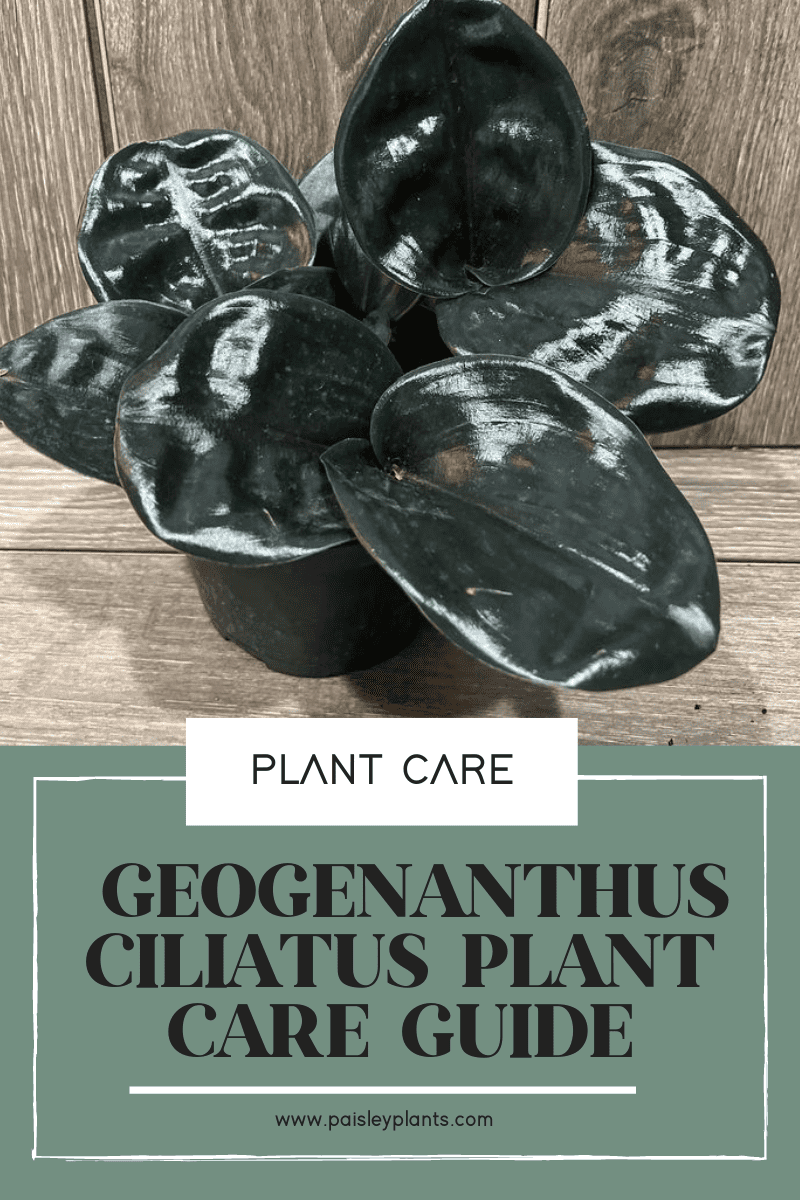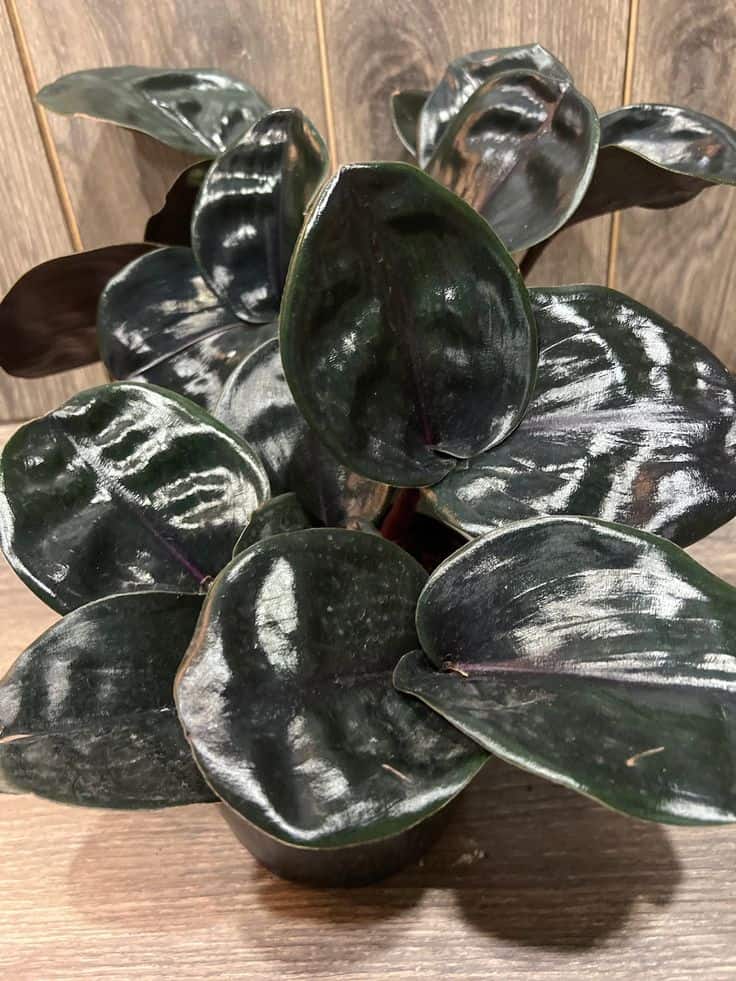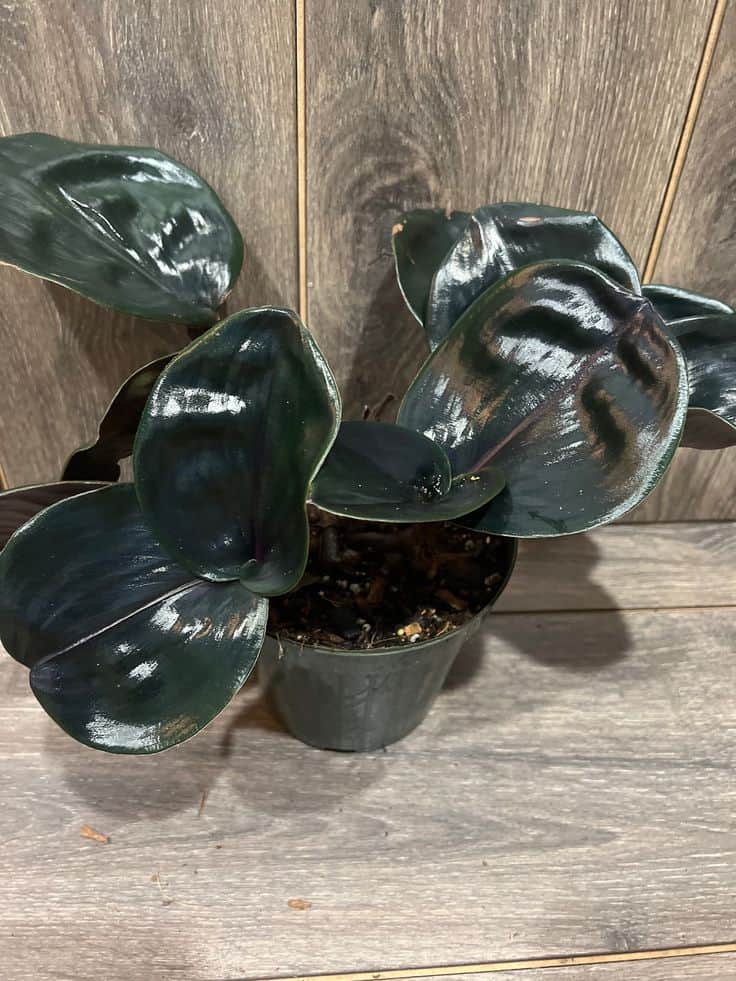Some plants have a big name and this is definitely one of them! But, thank goodness, this plant typically goes by just the name “Geo.” It is a relatively rare plant which has just come into vogue in the last few years as a houseplant.
Known for its deep dark purply black leaves, this beauty is one to give some different tones to your collection of indoor plants. Its leaves have a similar color as the ZZ Raven plant and aren’t your typical green leaf houseplant. They will add some definite interest to your houseplant collection because of their coloring.
Table of Contents
Geogenanthus Ciliatus Background and History

This post includes affiliate links.
This plant is a native of South America, mostly found in Ecuador and Peru. It typically lines the forest floor as an annual ground cover and thrives in low light conditions. It is a gorgeous flowering plant that is from the spiderwort family.
Common Names
As mentioned above, for the sake of ease, this plant is typically just called ‘Geo.’ It has been a relative newcomer to the houseplant world in recent years due to the fact that only plant collectors have had access to it for many years prior to that.
Now that growers like Costa Farms have propagated these plants, they are becoming more available to the average, every day houseplant parents.
Toxicity
Fortunately, the Geo plant is nontoxic to both humans and animals. This doesn’t mean they should be left near small children or pets, but it does mean that if they are ingested, there most likely won’t be any horrible side effects. Just be sure to keep all your plants out of reach of your kids or your pets!
Geogenanthus Ciliatus Care

Image used with permission via Tropical Plants FL
Water Requirements
Your Geo plant will like to have its soil kept moist. It shouldn’t be kept soaking wet, but it should not be left too long between waterings. You can let the top inch of the soil dry out before watering, then completely drench the soil when it’s time to water again.
Be sure that you have a well draining pot for your plant. You don’t want the roots to become too wet to avoid root rot and disease to your plant. When the roots remain healthy, this allows the oxygen to flow naturally and keeps the plant from dying.
Light Requirements
Because these plants naturally grow on the floor of the forest, they are able to be grown as low light plants. This means that you can keep your Geo plant in a place where the light isn’t too bright. It will do okay in a setting where there are dim light conditions.
You can keep it in medium to bright, but indirect lighting also. This can be achieved either by natural sunlight or with a grow light. Just be sure to keep your plant from direct sunlight, as this can burn the leaves and cause them to scorch.
Soil Requirements
The soil requirements for your Geo are relatively simple. A generic indoor plant soil or potting mix is fine. You just need to make sure that it is well draining. If you need to lighten the soil for better drainage, you can mix it with one part perlite or orchid bark to three parts potting soil mix.

Image used with permission via Tropical Plants FL
Fertilizing Requirements
As with most plants, your Geo will benefit from using a half-strength liquid fertilizer applied twice a month during the growing season (spring and summer months). There is no need to fertilize your plant, however, during the dormant months (fall and winter).
Temperature and Humidity Needs
Due to the fact that the Geo is a tropical plant, it loves higher humidity than most plants. It can tolerate humidity levels as low as 60%, but prefers levels closer to 90%. It will also help to use a humidifier if your home is very dry. This can keep the humidity level higher.
As far as the temperature range, anywhere between 60 to 80 degrees F is good. You should avoid temperatures below 50 degrees, however, as your Geo won’t do well in these temps. Also, remember to keep your plant away from cold windows or air conditioning vents.
Pests and Diseases
The most common pests for a Geo are spider mites, mealybugs and aphids. These pests all like to feed on plants. At the first sign of any of these pests, isolate your plant from the others. Use 70% isopropyl alcohol mixed with 80% water to spray on any visible pests.
You can also use antibacterial soap and water to wash any pests from under the stems and leaves of your plant. You could also use neem oil on a Q-tip on any problem leaves to get directly at a specific problem pest.
One of the most common diseases is root rot. This is generally from overwatering your plant. Be sure to keep a regular schedule for watering and do not let your plant sit in water! The roots need oxygen to keep the plant healthy and when they sit in water, they do not get the needed oxygen!
Pruning and Repotting
For the most part, your Geo doesn’t even require pruning. If you do decide to prune your Geo, you can do this during the winter months. This will help promote a fuller, bushier appearance to your plant when the next growing season rolls around come spring!
Since the nutrients in the soil mixture will typically break down (about once a year), it will be good to report your Geo annually. The new soil mixture will replenish the nutrients that will help your plant thrive.
Another good indicator that you need to repot your plant is when the roots begin to grow out of the drainage holes in the bottom of the pot. Use a pot that is one to two inches larger than the current pot when repotting your Geo.
Common Problems
Brown Leaves
This problem can sometimes be because of the water quality you use to water your Geo. Normal tap water can affect the plant if you don’t allow the chemicals in it to dissipate prior to using it to water. Let your tap water sit overnight before using it to water your plants. This should help solve the problem.
Root Rot
Root rot is a common problem for Geos since a lot of emphasis is placed on watering it. Be sure you have a regular watering schedule so as not to overwater or underwater your Geo. Keep the soil moist, but not soggy. This will help prevent root rot!
Muted Color on Leaves
This can happen if your leaves become too dusty. Be sure to keep the leaves clean by wiping the dust off. Chlorophyll is essential and will become blocked from the sun when the leaves are dirty. Gently wipe the leaves down with a damp cloth and this will help the color remain bright!
Curling Leaves
If the leaves are limp or curling, this may be an indication that your Geo is too dry. Also, if the leaves begin to turn brown and crispy, it may mean they need more water and humidity. Be sure to maintain a regular watering schedule to prevent this problem.
FAQs
It is highly unlikely your Geo will ever bloom indoors. In fact, it is rare that they even bloom when growing in the wild! They are known as reluctant bloomers, but when they do bloom, they have blooms that grow from the base of the plant that have three petals with thin white hairs growing from the tips.
Up until a few years ago, the Geo was hard to come by. In recent years, it has been propagated by growers and so now is easier to find for the average grower. You should be able to find one in an online store if you aren’t able to find one at your local garden center.
Surprisingly, your Geo can grow to be over eight inches long and the plant can stretch to over 24 inches wide! This will also depend on the size of the pot you have your Geo planted in.
In Conclusion
This plant creates a visually stunning contrast with brighter green plants due to its beautiful deep purple foliage. Its addition to any houseplant collection will make for some interesting conversation, for sure!
This plant won the coveted “Best New Foliage” award at the 2022 Tropical Plant International Expo. Maybe it’s time you found one to add to your home or office and see what all the buzz is about! As always, keep on growing!
